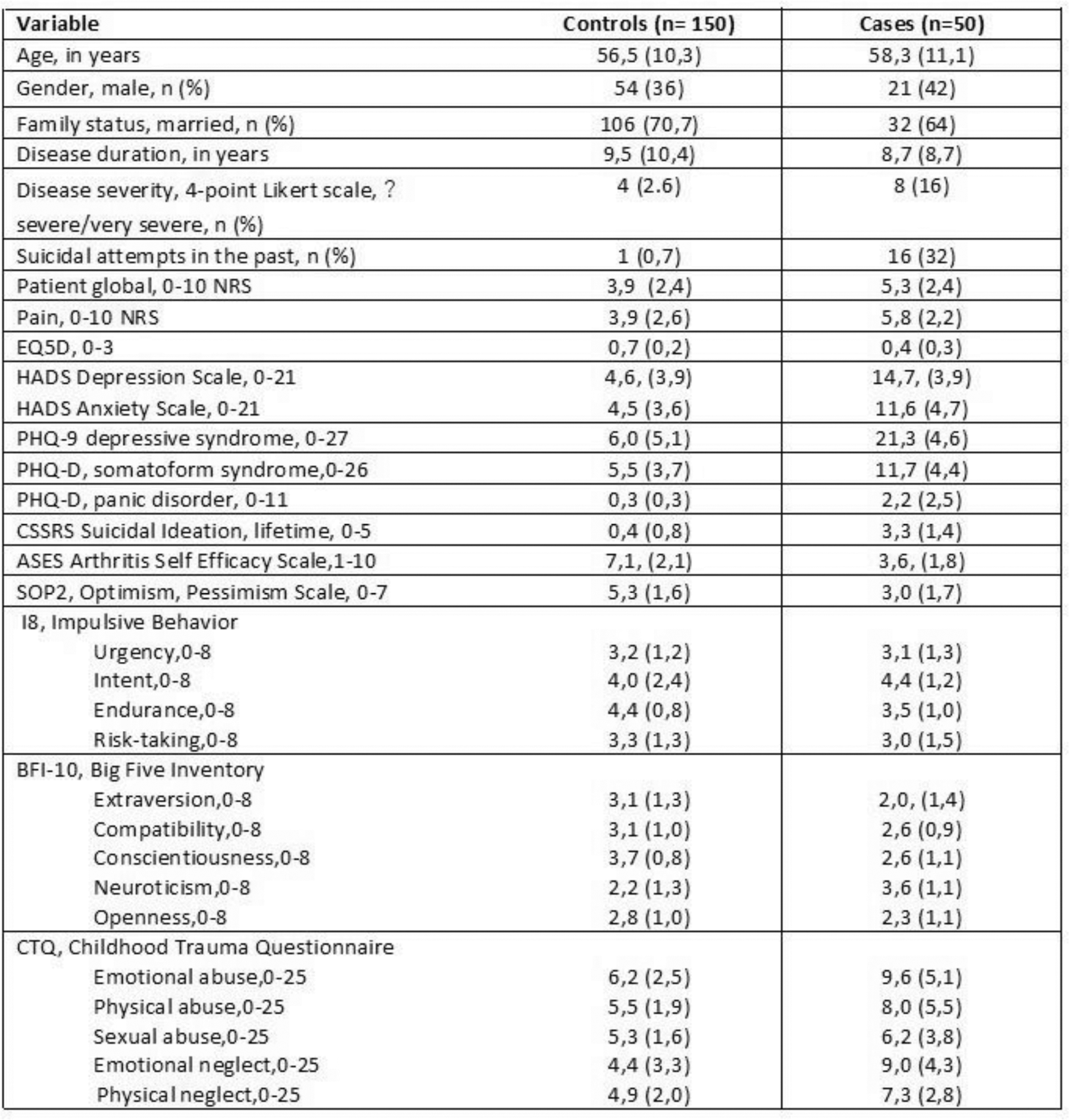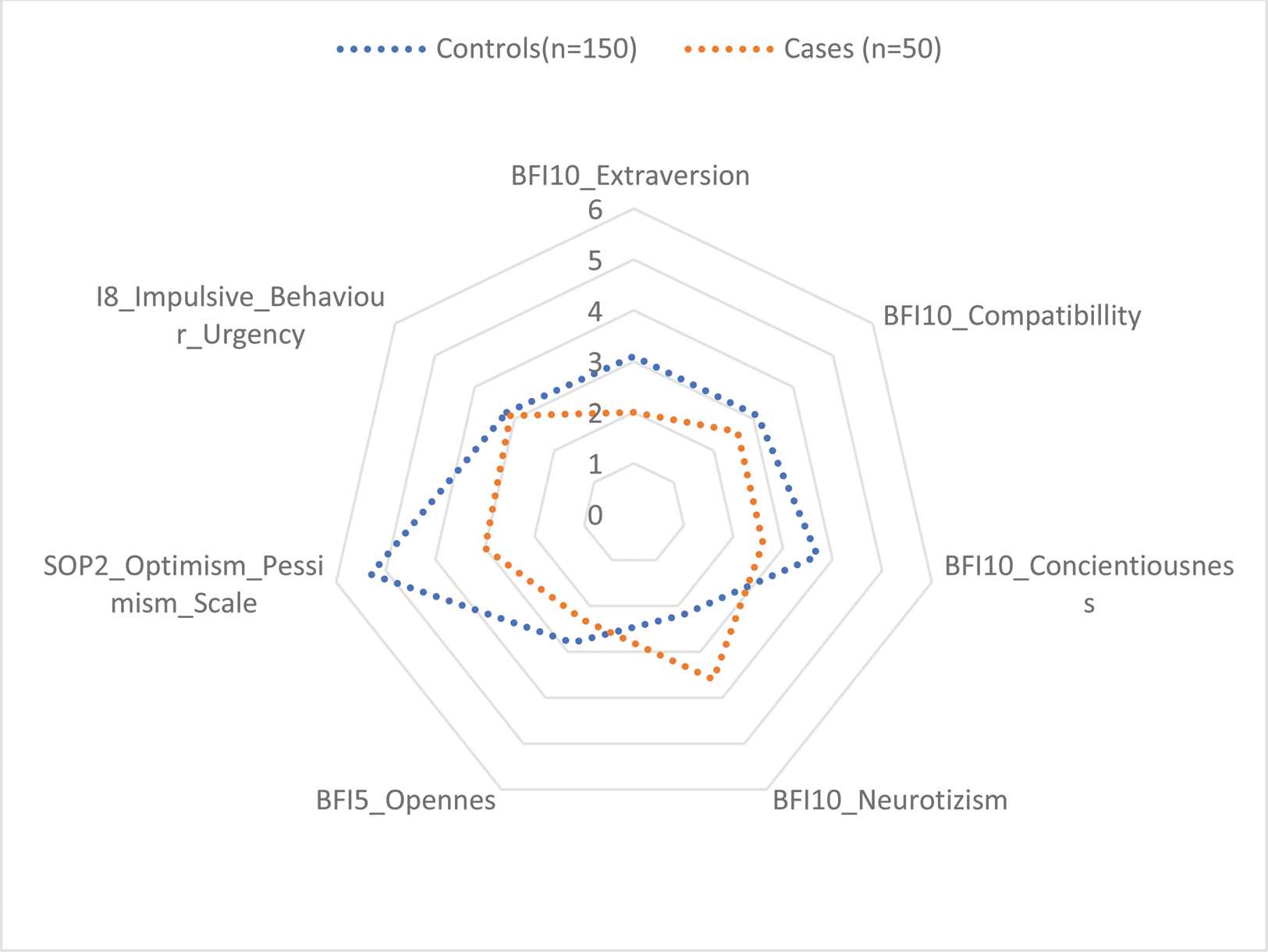

Background: Mental health contributes significantly to the morbidity observed in patients (pts) with inflammatory rheumatic musculoskeletal diseases (iRMD). Despite extensive research conducted on the prevalence of depressive disorders, limited data regarding occurrence of suicidal ideation among iRMD pts is available.
Objectives: This study aims to evaluate the prevalence of suicidal ideation in a cohort of iRMD pts and to explore the factors that are associated with suicidal ideation.
Methods: We identified cases from the German observational LORE cohort, consisting of pts with various types of iRMD, who reported suicidal ideations (using PHQ-9) at least weekly between May 2022 and April 2023. These cases were matched in a 1:3 ratio for age and gender with pts from the same cohort who did not report any suicidal ideations. Patient’s and disease characteristics such as disease activity, physical function, mental health, and disease severity as well as factors that are reported to be associated with suicidal ideations, such as previous suicidal attempts, childhood trauma, personality factors, and psychological comorbidity were assessed in a case control study. A standardized clinical interview conducted by a mental health specialist was offered to all identified cases and mental disorders were diagnosed through both extensive clinical evaluation and the standardized Diagnostic Interview for Mental Disorders - Mini-DIPS Open Access. Psychosomatic experts and rheumatologists rated independently whether suicidal ideation was being casual related to iRMD (NRS 0-10, 10 strong confidence in causal relationship). Columbia Suicidal Severity Rating Scale (C-SSRS) were used to assess lifetime suicidal ideation. Factors probably associated with risk of suicidal ideation were investigated using multivariable logistic regression analysis.
Results: We identified a total of 95 cases out of 2960 pts resulting in a prevalence of suicidal ideations of 3.2%. Among these cases, 50 completed the questionnaires, while 150 individuals served as controls. While demographics did not differ significantly between cases and controls, patient’s reported outcomes were substantially higher in cases than controls (Table 1). In addition, it was observed that personality factors such as pessimism and neuroticism differed between cases and controls (Figure 1). The clinical interviews by mental health specialist in 25 cases (50%) showed a high prevalence of major depression (20 (80%)), somatoform stress disorders (16 (64%)) and trauma-related disorders (9 (36%)). In addition, patients suffered from addiction syndromes (4 (16%)) and anxiety disorders (3 (12%)). Predictors for suicidal ideation where and neurotic personality (OR 5.39 (95%CI 1.70-28.3), impulsivity (OR 2.0 (95%CI 1.06-4.39), presence of somatoform distress disorder (OR 1.63 (95%CI 1.09 -2.88) and shorter disease duration (OR 0.94 (95%CI 0.69-0.96). Confidence in causal relationship between iRMD and suicidal ideation was reported by psychosomatic experts with higher values than by rheumatologists (5.4 (3.5) versus 1.6 (1.6)).
Conclusion: A substantial number of pts reported suicidal ideation in our observational cohort. Of interest, most vulnerable groups were pts with neurotic personality, somatoform stress disorder and shorter disease duration. Interestingly, known risk factors for suicidal ideation in the general population were not identified as such in our study. Larger-scaled studies would be instrumental to unravel suicidal ideation and its underlying factors in pts with iRMD.
REFERENCES: NIL.
Table 1. Patient characteristics of subjects with and without suicidal ideation

Spydergram of personality factors by cases and controls

Acknowledgements: NIL.
Disclosure of Interests: Eike von Schlichting: None declared, Jan Dieris-Hirche: None declared, Imke Redeker: None declared, Xenofon Baraliakos AbbVie, Amgen, Chugai, Galapagos, Lilly, MSD, Novartis, Pfizer, UCB and Sandoz., AbbVie, Amgen, Chugai, Galapagos, Lilly, MSD, Novartis, Pfizer, UCB and Sandoz., AbbVie, Amgen, Chugai, Galapagos, Lilly, MSD, Novartis, Pfizer, UCB and Sandoz., Uta Kiltz AbbVie, Amgen, Eli, Lilly, Fresenius, Hexal, Janssen, Novartis, UCB, AbbVie, Amgen, Eli, Lilly, Fresenius, Hexal, Janssen, Novartis, UCB, AbbVie, Amgen, Eli, Lilly, Fresenius, Hexal, Janssen, Novartis, UCB.